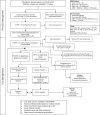Surviving sepsis: going beyond the guidelines
- PMID: 21906348
- PMCID: PMC3224476
- DOI: 10.1186/2110-5820-1-17
Surviving sepsis: going beyond the guidelines
Abstract
The Surviving Sepsis Campaign is a global effort to improve the care of patients with severe sepsis and septic shock. The first Surviving Sepsis Campaign Guidelines were published in 2004 with an updated version published in 2008. These guidelines have been endorsed by many professional organizations throughout the world and come regarded as the standard of care for the management of patients with severe sepsis. Unfortunately, most of the recommendations of these guidelines are not evidence-based. Furthermore, the major components of the 6-hour bundle are based on a single-center study whose validity has been recently under increasing scrutiny. This paper reviews the validity of the Surviving Sepsis Campaign 6-hour bundle and provides a more evidence-based approach to the initial resuscitation of patients with severe sepsis.
Figures
References
-
- Dellinger RP, Carlet JM, Masur H, Gerlach H, Calandra T, Cohen J, Gea-Banacloche J, Keh D, Marshall JC, Parker MM, Ramsay G, Zimmerman JL, Vincent JL, Levy MM. Surviving Sepsis Campaign guidelines for management of severe sepsis and septic shock. Crit Care Med. 2004;32:858–873. doi: 10.1097/01.CCM.0000117317.18092.E4. - DOI - PubMed
-
- Dellinger RP, Levy MM, Carlet JM, Bion J, Parker MM, Jaeschke R, Reinhart K, Angus DC, Brun-Buisson C, Beale R, Calandra T, Dhainaut JF, Gerlach H, Harvey M, Marini JJ, Marshal J, Ranieri M, Ramsey G, Sevransky J, Thompson T, Townsend S, Vender JS, Zimmerman JL, Vincent JL. Surviving sepsis Campaign: International guidelines for management of severe sepsis and septic shock: 2008. Crit Care Med. 2008;36:296–327. doi: 10.1097/01.CCM.0000298158.12101.41. - DOI - PubMed
LinkOut - more resources
Full Text Sources
Other Literature Sources


